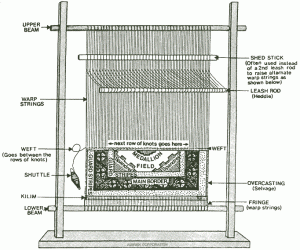The Anatomy of the Rug
Rugs and flooring in general, are such an interesting idea. They’re beautiful, and functional, and comfortable, all rolled into one (no pun intended). They have evolved into so many different looks and designs over hundreds of years, every reiteration improving more and more. It’s mind boggling to think about what they could look like one hundred, two hundred, five hundred years from now.
Knox Carpets has always had an innate interest in the composition of rugs and flooring. When you get up close to the hooking, to the back of the rug, examining each loop. It’s crazy to look at the different colors that can be woven so intricately. Rugs differ so much from one material to the next. It’s a unique science, the making of rugs, and we make it our business to become scientific rug masters.
There are several buzzwords that you’ll want to become familiar with, if you’d like to join us in our epic quest to become scientific rug masters. This diagram below, gives you a good visual.
This is most applicable for more intricate woven rugs, but still valuable information for you to have. Rugs like this one, and many in the Oriental style, are created using a loom. You can see that the loom is bordered on top and bottom by beams– an upper and a lower (imagine that!). A shed stick helps lift alternating warp strings for the yarn to pass through. The fringe on the top and bottom of the rug are created by access warp strings. You can see in this diagram call-outs for the Killim, Guard Stripes, Main Border, Spandrel, Field and Medallion. Not all of these are necessary, it’s totally up to you as far as your design aesthetic.
Let’s break these down a little bit-
The warp is the main backbone of any Oriental carpet. The warp is made up of yarn strands stretching from the top to bottom of the rug, running length-wise. The yarn strands are stretched across the loom, and then weaving begins. After the rug is done, it’s cut from the loom. As you know, then the ends of the warp become the fringe. It’s most common for the warp to be made up of cotton, silk or wool.
The pile is a collection of yarn knots, twisted in between the strands of the warp. There are different styles of knots like Turkish (Ghiordes, Symmetrical or Traditional) or Persian (Asymmetrical, Commercial or Senneh). The Persian knot is a single knot. It’s created by looping your pile yarn in between two warp strands. Then you draw it back through one warm strand. The Turkish knot goes through two warp strands and then is drawn back through both. As you can tell, the Turkish knot is a little bit more difficult. However; it’s a lot more durable than a Persian knot.
The weft is strands of yarn which are inserted horizontally to the warp strands. They’re then woven in and out of the warp strands. The weft is normally made of the same material as the warp, but it’s only actually visible when you’re looking at the back of the rug. The number of weft strands in between the rows of knots are your shoots.
The rug’s edges are covered with what is called the overcast. The overcast is a simple running stitch. This helps reinforce the edges of the rug, which are the most susceptible to wear and tear.
Now you’re well on your way to being a scientific rug expert!


